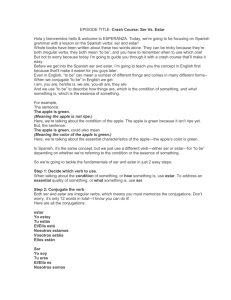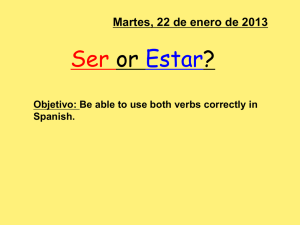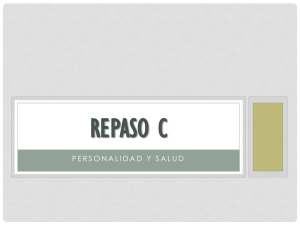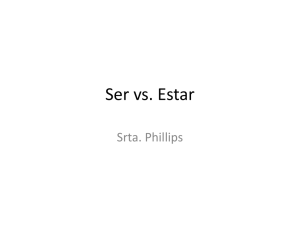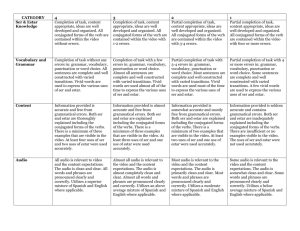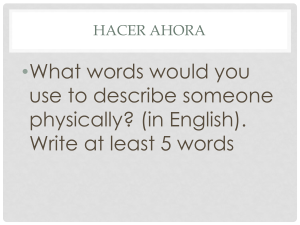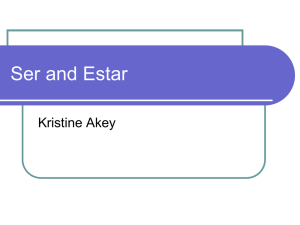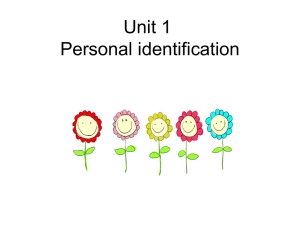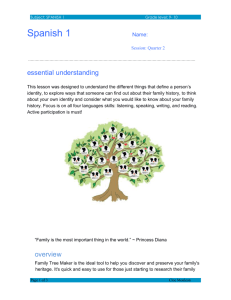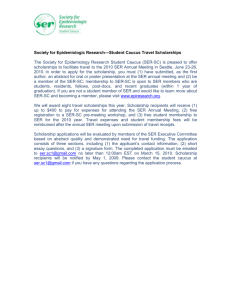I. En General Ser and estar can both be translated as "to be." Here
advertisement
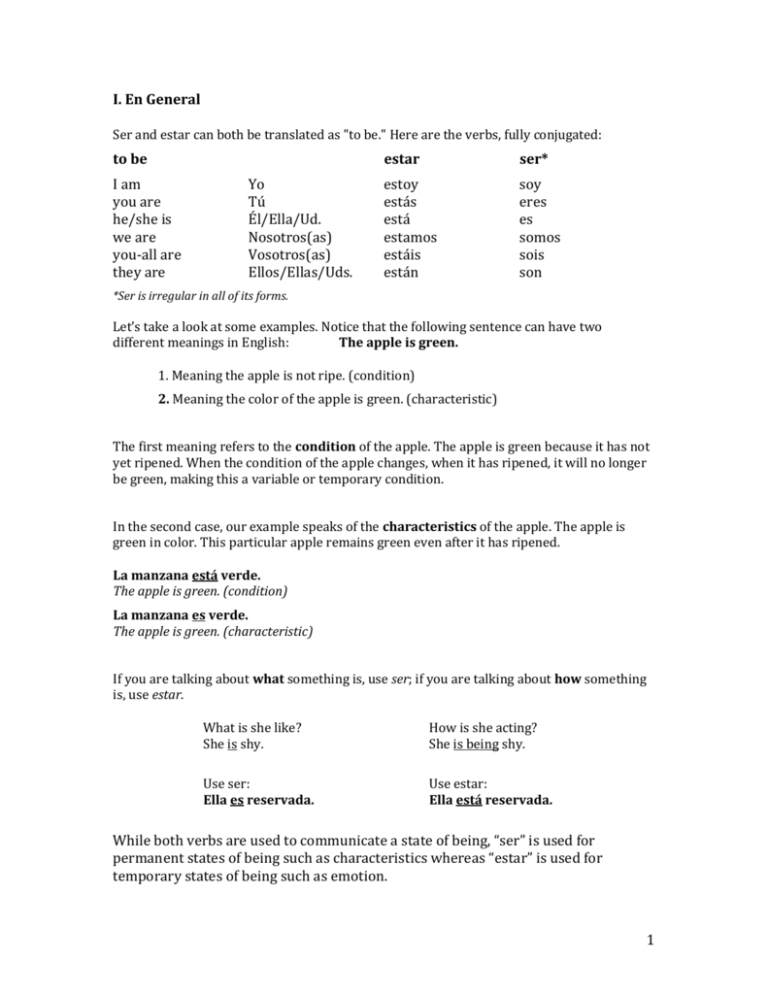
I. En General Ser and estar can both be translated as "to be." Here are the verbs, fully conjugated: to be I am you are he/she is we are you-all are they are Yo Tú Él/Ella/Ud. Nosotros(as) Vosotros(as) Ellos/Ellas/Uds. estar ser* estoy estás está estamos estáis están soy eres es somos sois son *Ser is irregular in all of its forms. Let’s take a look at some examples. Notice that the following sentence can have two different meanings in English: The apple is green. 1. Meaning the apple is not ripe. (condition) 2. Meaning the color of the apple is green. (characteristic) The first meaning refers to the condition of the apple. The apple is green because it has not yet ripened. When the condition of the apple changes, when it has ripened, it will no longer be green, making this a variable or temporary condition. In the second case, our example speaks of the characteristics of the apple. The apple is green in color. This particular apple remains green even after it has ripened. La manzana está verde. The apple is green. (condition) La manzana es verde. The apple is green. (characteristic) If you are talking about what something is, use ser; if you are talking about how something is, use estar. What is she like? She is shy. How is she acting? She is being shy. Use ser: Ella es reservada. Use estar: Ella está reservada. While both verbs are used to communicate a state of being, “ser” is used for permanent states of being such as characteristics whereas “estar” is used for temporary states of being such as emotion. 1 II. Usos del “Ser” 1. Ser is used to express the hour, day, and date. ¿Qué hora es? What time is it? Son las dos. It's two o'clock. ¿Qué día es hoy? ¿Cuál es la fecha hoy? What day is today? What is today’s date? Hoy es viernes Hoy es el 2 de abril. Today is Friday Today is April second. 2. Ser is used to express place of origin. 3. Ser is used to express occupation. ¿De dónde eres tú? ¿Cuál es tu trabajo? Where are you from? What do you do? Soy de San Salvador, El Salvador. I'm from San Salvador, El Salvador. Soy profesora. 4. Ser is used to express nationality. I'm a teacher. 5. Ser is used to express religious or political affiliation. ¿Es ella puertorriqueña? ¿Eres demócrata? Is she Puerto Rican? Are you a democrat? No, es guatemalteca. Sí, soy democrata. No, she's Guatemalan. Yes, I’m a democrat. 6. Ser is used to express the material made of. 7. Ser is used to express something is possession. ¿De qué material es la mesa? ¿De quién es el zapato? Es de madera. Es de Emillio. What's the table made of? It's made of wood. 8. Ser is used to express the relationship of one person to another. Whose shoe is it? It’s Emilio’s 9. Ser is used with certain impersonal expressions. .¿Quién es Roberto? Es necesario hablar mucho. Who is Robert? It’s necessary to speak a lot. Es el esposo de Marta. He's Martha's husband. 10. Ser is used to tell where an event is taking place. El baile es en el gimnasio. The dance is in the gym. 11. Ser is used with adjectives to express inherent, or essential qualities. Martín es talentoso. Martin is talented. 2 III. Usos del “Estar” 1. Estar is used to express geographic or physical locations. ¿Dónde estás? ¿Dónde está Chile? Estoy en el baño. Chile está en América del Sur. Where are you? I'm in the bathroom. Where is Chile? Chile is in South America. Note: The one exception to this rule is that ser is used to tell where an event is taking place. (La fiesta es en mi casa.) 2. Estar is used with adjectives to express a state or condition ("how" something is). ¿Cómo está la sopa? ¿Cómo está María? How's the soup? How is Maria? La sopa está fría. María está feliz. Maria is happy. The soup is cold. 3. Estar is used with many idiomatic expressions. These are just a few: estar de acuerdo estar de pie to be in agreement to be standing estar en camino estar en las nubes to be on the way to daydream 4. Estar is used with the progressive tenses. ¿Qué estás comiendo? What are you eating? Estoy comiendo arroz y frijoles. I am eating rice and beans. IV. Más información When the verb "to be" is followed by a noun, the verb “ser” is always used. In this instance, it might be helpful to think of the verb as equivalent to an "equal" sign, such as a = b. This type of sentence is always referring to essential characteristics, since the verb is "linking" what comes before the verb to what comes after the verb. John is a doctor. John = doctor. Juan es médico. 3 When the verb "to be" is followed by an adjective, the verb used depends upon the meaning. When referring to a characteristic, use “ser”. When referring to a condition, use “estar”. Los elefantes son grandes. La pizza está fría. The elephants are big. The pizza is cold. When the verb "to be" is followed by an adjective, the verb can actually change the meaning of the adjective. El profesor es aburrido. El profesor está aburrido. The professor is bored. The professor is boring. To describe origin, or where something is from, use “ser”. To tell where an event is taking place, use ser. To describe location, or where something is located right now, use “estar”. Mónica es de España. (origin) La fiesta es en la casa de Mónica (taking place) Mónica está en Venezuela. (location) V. Repaso 1. 2. 3. 4. 5. When a noun follows the verb, use ser When an adjective follows the verb, decide between "essence" and "condition" To tell where something is from, use ser To tell where something is located right now, use estar To tell where an event is taking place, use ser Ser 1. 2. 3. 4. 5. 6. 7. 8. 9. 10. 11. the hour, day, and date place of origin occupation nationality religious or political affiliation the material something is made of possession relationship of one person to another certain impersonal expressions where an event is taking place essential qualities Estar 1. 2. 3. 4. geographic or physical location state or condition many idiomatic expressions progressive tenses 4
